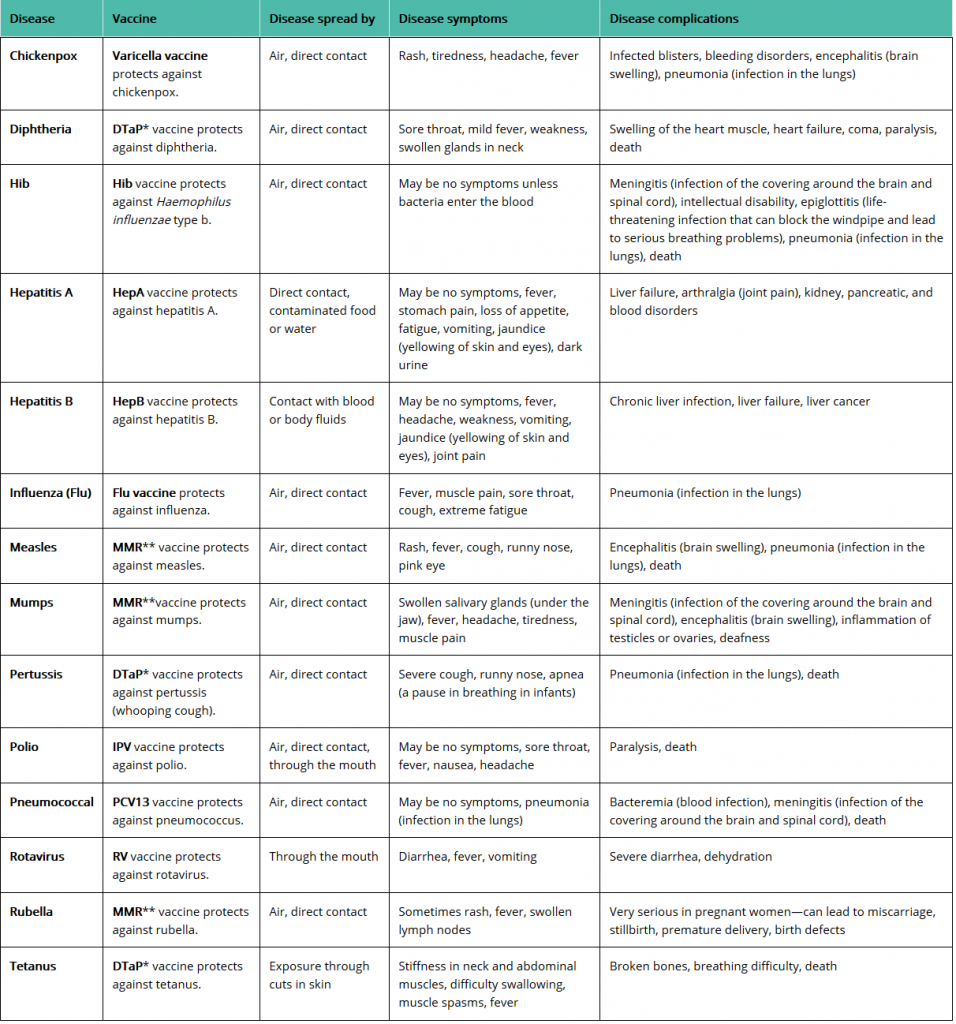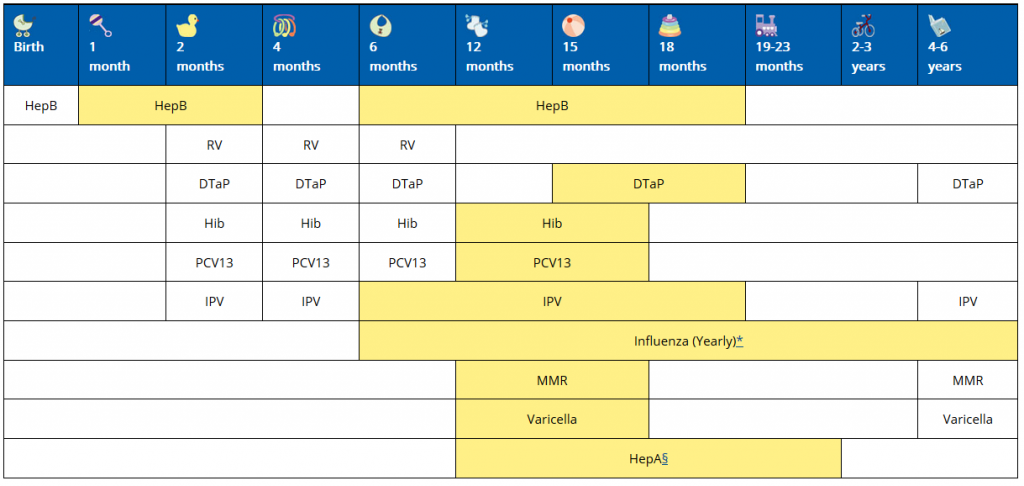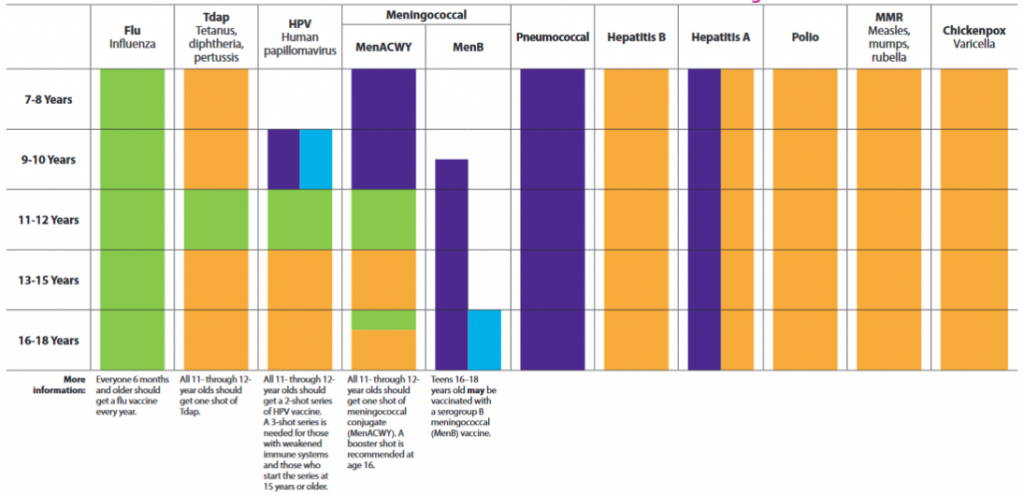
What is a vaccine?
A vaccine is created using dead or small amounts of a weak germ which is known to cause a specific disease. These vaccines are used to prepare our bodies to fight against bacteria, viruses or toxins. The term vaccination means to receive the vaccine (which is typically given through a shot).
What kinds of vaccines are there?
Vaccines are created based on how our bodies defense system protects us against a germ. When a vaccine is created scientist keep in mind how we fight off certain germs, who needs to be vaccinated and what is the best way to create a vaccine for a specific bacteria, germ or toxin.
LIVE-ATTENUATED VACCINES
This type of vaccine uses weak forms of a germ that is known to cause disease. When we use this type of vaccine we create a stronger, longer lasting immune response because the vaccine is very similar to the actual infection.
What they protect against: Measles, mumps, rubella (MMR combination), rotavirus, smallpox, chickenpox and yellow fever.
INACTIVATED VACCINES
This type of vaccine uses a dead version of the germ. With using a dead germ instead of a living one, the immunity is not as strong and may require several doses overtime (booster shots) to build immunity against the disease.
What they protect against: Hepatitis A, Flu (shot only forms), Polio (shot only forms) and Rabies.
SUBUNIT, RECOMBINANT, POLYSACCHARIDE & CONJUGATE VACCINES
These types of vaccines use a certain part of the germ to create the vaccine, such as a protein, sugar or casing around the germ. Due to this vaccine targeting a specific part of the germ there is a very strong immune response. However, booster shots may still be necessary.
What they protect against: Hib, Hepatitis B, Human papillomavirus (HPV), Whooping cough, Pneumococcal disease, Meningococcal disease and Shingles.
TOXOID VACCINES
This type of vaccine uses a the harmful product (toxin) created by the germ. This creates an immunity to the toxic parts of the disease instead of the germ itself. This vaccine may also require booster shots.
What they protect against: Diphtheria, Tetanus.
Centers for Disease and Control Prevention (CDC) List of Diseases and Vaccines

The “Truth Behind Vaccines” is a short video educating the population on how undermining and rumors about vaccines have caused harm and the uprising of preventable diseases. It’s statistics are eye opening on how quickly a once diminished disease can reproduce. The strongest argument in this video is showing us how not vaccinating can harm not only the individual themselves but also others around them.
Why Vaccines are needed?
Just about every year thousands of Americans encounter a preventable disease in which a vaccination could have given them immunity from. Vaccinations are recommended based on many factors such as age, health, lifestyle and job. Through extensive research and testing vaccines are created to protect individuals who are vulnerable to illness due to immune system issues and chronic conditions. Without these vaccinations the risk infection is rising. Many of us have never seen any of these preventable diseases in which once claimed many lives every year. We have had this luxury due to vaccinations protecting us from the germs in which still exist and can be spread. Getting vaccinated not only protects the person in which receives it but it also helps protect the spread of the disease to others who cannot protect themselves.
2019 Recommended Immunizations from the Centers for Disease and Control Prevention (CDC) for Birth to Eighteen Years of Age


Negative or Positive Information?
Trying to determine myths from the truth when it comes to vaccinations is overwhelming and never ending. There is constant battling between the PRO and CON groups everywhere we look. There are multiple books, websites and media videos fighting for your attention in this matter. How do we know who to believe? Doctors and scientists use data and experiments to determine safety and . According to a new survey done in 2018, approximately 1 in 8 children under the age of two are under-vaccinated. Studies have showed that there is a negative influence through television and newspapers as well as with new technology and social media having misinformation. The acceptance of vaccines is decreasing and our doctors are more important than ever to help shed knowledge and positive attitudes on vaccinations. With proper education we have the ability to improve our decision-making process to one in which is enlightened and our own.
Today there are so many websites giving us information. How do we determine who to trust? This video is a real-life account of an incident with an unvaccinated child and her mother’s journey to find answers. We just need to be willing to listen and participate in our own research.
Our Opinion or Someone Elses?
I choose to end with this video showing us the science behind anti-vaccination. This video explains the psychological effects the media and other people opinions have on our thought process. This video allows us to question what we truly know about vaccinations and if our opinions are actually our own. The choice to vaccinate or not is ultimately a choose no one should make for you, however, the choice in which you make should be an educated one. When it comes to our lives and the lives of those around us, a little bit of research is worth a shot.
Refences
Facciola, A., Visalli, G., Orlando, A., Bertuccio, M. P., Squeri, R., Picerno, I., Di Pietro, A. (2019). Vaccine hesitancy: An overview on parents opinions about vaccination and possible reasons of vaccine refusal. Journal of Public Health Research, 8(1), 13–18.
Sarvesh Kumar, J., & Brundha, M. P. (2018). Awareness about childhood vaccination among parents with children below 15 years of age. Drug Invention Today, 10(12), 2481-2484.
U.S. Department of Health and Human Services. Vaccines & immunizations. Centers for Disease Control and Prevention. March 28, 2019 last reviewed. https://www.cdc.gov/vaccines/vac-gen/vaxwithme.html
U.S. Department of Health and Human Services. Vaccine basics. Vaccines.gov. December 2017 last reviewed. https://www.vaccines.gov/basics
